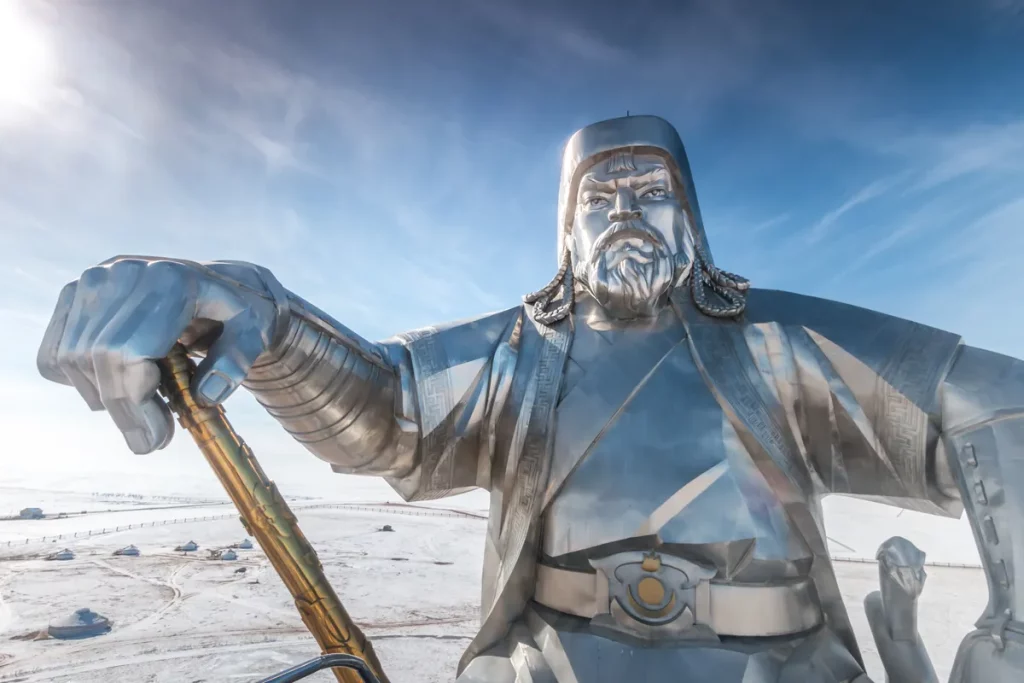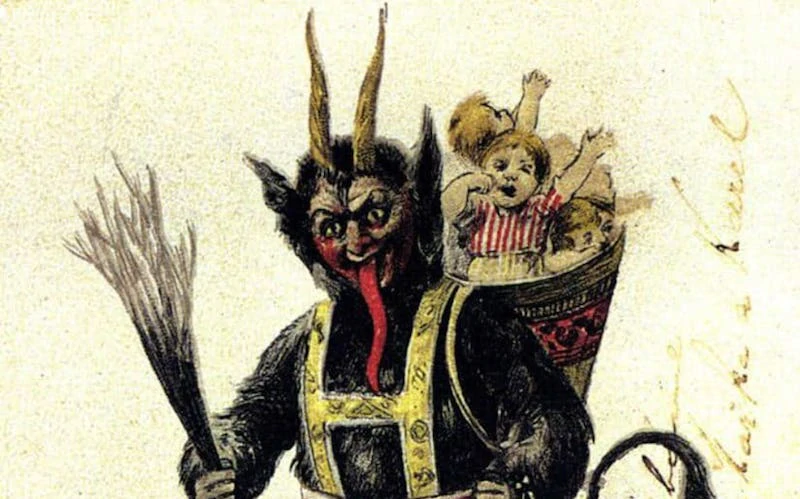Last updated on March 1st, 2023 at 04:53 pm
Gengis Khan is one of the most renowned conquerors ever known to man. He was a leadership phenomenon famous for successfully uniting the Mongol tribes into a single independent polity and establishing the legendary Mongol Empire, which became the world’s largest land empire ever ruled by one man.
To add to his already astonishing legacy, a groundbreaking study published by the American Society of Human Genetics in the wake of the 21st century revealed that genetic traces of the famed Mongolian Emperor were found in 1 in 200 men worldwide.

The Legend of Genghis Khan
Temüjin, more famously known by the title of Genghis Khan, was born into the Borijin clan sometime during the mid-12th century.
Temüjin was the son of Hoelun, who had been allegedly kidnapped and coerced into marriage by his father Yesugei, and the great-grandson of the first known Khan of the nomadic Khamag Mongol confederation, Kabul (also known as Qabul) Khan.
According to legend, Temüjin was born grasping a blood clot in his right fist, indicating that he would become a great leader. Temüjin’s ancestry can be traced to a renowned Mongol warlord and founder of the Borijin named Bodonchar Munkhag, who died sometime around the 10th century C.E.
Much of what is known about the Borijin tribe before Bondonchar Mukhang is considered chiefly as legend or myth. Although, The Secret History of the Mongols explains that his ancestry is descended from the union of a deer and a wolf. How this unusual union between two animals was able to produce a human child, I cannot quite explain.
Temüjin grew up in and around much violence and turmoil. His father, Yesugei, had the ambition to unite the Mongols and claim the title of the Khan but was murdered by a rival clan when Temüjin was nine years old. This resulted in his family being rejected by their tribe and ultimately struggling for survival.
After Yesugei’s death, Temüjin’s older half-brother tried to establish dominance as the head of the family, resulting in Temüjin killing his brother and taking over.
Temüjin swiftly rose to power when he orchestrated and led successful attacks against rival tribes in Khamal Mongol confederate. He was able to amass a considerable band of followers by demonstrating great bravery and skill in battle conquests and raids.
He also had a penchant for breaking the traditional Mongol practice of delegating authority based on blood ties, favoring a more meritocratic system based on talent, loyalty, and achievements. He would go on to win battle after battle, annihilating countless enemies in his path.
In 1206, Temüjin had not only built a reputation as a terrific warrior but also successfully carried out the annexation and unification of many Mongol nomadic tribes of Northeast Asia.
This led him to be crowned in a general assembly of chiefs of the Mongol tribes known as Kurultai as “Genghis Khan” (the supreme Khan or King of all Mongols).
There wasn’t such a thing as a Mongol Empire before Ghenghis Khan. Temüjin achieved this incredible feat by successfully uniting the Mongol tribes under his leadership into what was later known as the Mongol Empire.
The Great Khan waged wars against neighboring kingdoms stretching outward from the Mongolian plateau, culminating in the infamous “Mongol Invasions” that terrorized large parts of Eurasia in the 13th and 14th centuries.
Genghis Khan and his horde of Mongol armies ruthlessly staged an unprecedented scene of carnage in Eurasia that led to the deaths of an estimated 40 million people.
They conquered an astounding amount of land mass in their wake, stretching from modern-day China and Iran to the Caspian Sea, with his generals raiding Russia and Persia.
His descendants would go on to further extend the rule of this empire to even farther places such as Korea, Vietnam, Syria, and even Poland.
However, Genghis Khan’s legacy goes beyond his establishment of a historically massive empire through warfare. He also had novel ideas on governance, which shaped the core of the Mongolian political structure.
He commissioned the adaptation of a script for the Mongolian language so that it could be used to document records. Khan also established a law code for the Mongols.
Because it was too large to be governed by a single monarch, Genghis Khan devised unique strategies to strengthen and expand the Mongol Empire, like allocating parts of his conquered territories to his close relatives for them to rule.
Another effective strategy Khan employed was making many strategic marriage alliances with his sons and daughters based on Quda. Quda was the traditional marriage alliance system adopted by the Mongolians.
Genghis Khan used this to marry his offspring into notable dynasties and ruling lineages of neighboring kingdoms and solidify his family’s reign.
This proved a very important diplomatic that allowed his descendants to maintain territorial dominance within the Mongol Empire.
In 1227 Genghis Khan died at the estimated age of 65. The exact cause of his death remains a matter of historical debate. One source cites his cause of death as caused by a plague, and others claim he died due to complications from injuries he sustained on the battlefield.
There was a particularly audacious report that he was castrated by a Chinese princess, which resulted in him bleeding to death.
The Genetic Legacy of Genghis Khan
A study was published in 2003 by the American Journal of Human Genetics. An international team of geneticists led by Chris Tyler-Smith had identified that a rather vast number of men across a large region of the Asian continent carried the same haplotype on their Y-chromosome, which indicated a shared lineage paternal lineage.
A haplotype refers to a group of alleles of different genes present in a single chromosome that can be linked closely enough to be inherited as a unit.
A group of similar haplotypes is a haplogroup. The paternal ancestry of a selected group of persons can be identified by tracing specific haplogroups attached to the Y-chromosome.
This unique haplotype is said to be found in 16 million men, which accounts for about 8 percent of the current Asian male population and 0.5 of the world population, which is far beyond the normal expectations of standard genetic variations over such a large area.
The study determined that the reason for 16 million male individuals sharing a remarkably identical Y-chromosome could only be the result of selective inheritance. A specific genetic line has been successfully replicated more than others, indicating an origin from a particular “Alpha Male” figure in the period.
The haplogroup was traced to Mongolia, and with the aid of a batwing program, it was determined the most recent direct common ancestor lived approximately 12 to 13 centuries ago.
Given the circumstances, only one man sticks out at that particular historical time that properly fits the description.
Only he had the opportunity to have his genes spread across so much of Asia and be continuously selected for centuries after he had passed on… that man was none other than Genghis Khan.
Ghengis Khan had a lot of wives, concubines, and children, which remained undocumented throughout his lifetime. Still, keeping with Mongol tradition, only the sons of Bôrte (the chief wife) were considered legitimate heirs to the Khan.
The Great Khan and his closest descendants were known to have fathered hundreds of children. Even though the Mongol empire disintegrated into smaller political units over time, his direct descendants ruled large parts of Asia in one form or another for many centuries.
How many descendants does Genghis Khan have today?
It is a particularly fascinating discourse, debating whether Genghis Khan is the sole progenitor of 16 million individuals living today.
While it has been commonly accepted that 16 million males currently living across Asia have a common ancestor from the 12th century A.D. in Ghengis Khan, this hypothesis must be proven with certainty since there is no way to get Genghis Khan’s actual genome.
No real genealogical evidence exists to back this claim to date because no human remains of Genghis Khan or any other known family member have ever been found.
Vital genealogical data of most of the close relatives of Genghis Khan completely vanished long before the advancement of modern genetic sciences.
Recent studies have described the main thesis of the 2003 study that claims Genghis Khan and his close male relatives are the likely progenitors of 1 in every 200 men in Asia as being too simplistic or containing loopholes.
Some researchers have pointed out that the common male ancestor of whom 0.5 of the world’s male population is sired is likely not Genghis Khan but rather quite possibly from a male ancestor higher up in his male line.
Moreover, the amount of mutation concerning the figures supports an origin that likely dates back to years before Genghis Khan was born.
Descendants of Genghis Khan are also technically descendants of his great-grandfather Kabul Khan and the renowned founder of the Borijin tribe Bodonchar Munkhag.
Since the sample size for the 2003 study by the American Society of Human Genetics was based on a random selection of people rather than the actual genealogical data of Genghis Khan, there’s bound to be intersections, and the further back we try to go the more the possibility that there could be overlaps.
While it would require more factual evidence to convince me, I wouldn’t dismiss that someone with such an astonishing legacy of success as Genghis Khan wouldn’t equally have an incredible legacy of procreation.
Certain records estimate that Genghis Khan had sexual relations with as many as 2000 females during his lifetime.
While this can very well be considered an outlandish number, one point to note is that the Mongol horde, pioneered by Genghis Khan, was remarkably successful in invading, conquering, and exerting territorial dominance over the largest contiguous land empire ever known to man.
The booty from these massive conquests most definitely comprised the most desirable females married off to or possibly raped by the Khan. Genghis Khan himself was attributed with the quote;
“The Greatest Happiness is to scatter your enemy and drive him before you. To see his cities reduced to ashes. To see those who love him shrouded and in tears. And to gather to your bosom his wives and daughters.”
This points to a plausibility of Ghengis Khan being at the forefront of the raping and other large female amassing possibilities that were part of the dividends of such massive conquests.
However, citing rape as the vital factor in Genghis Khan’s prolific genetic legacy is a non-trivial fact that strikes me as modern-day projecting.
His descendant’s continued success of selective marriage into royal families, with each male descendant having a high number of children for generations due to the prestige associated with Genghis Khan’s lineage, seems more likely to be a massive determinant of this feat.
One of Genghis Khan’s sons was recorded to have fathered 40 sons with his wife and concubines, with the possibility of having many other illegitimate children from many other women.
Statistically, there could be 16 million male descendants carrying his gene. However, to prove with absolute certainty that this is factually correct is something we’ll never know.

